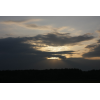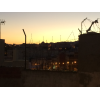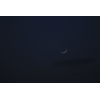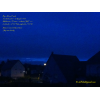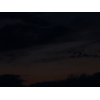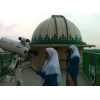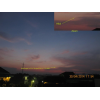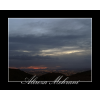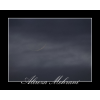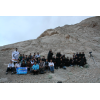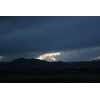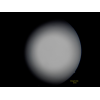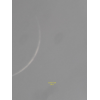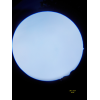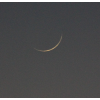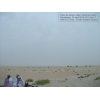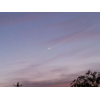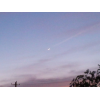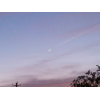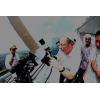Visibility of Rajab Crescent 1435 AH
- When to Observe Rajab Waxing (NEW) Crescent ?
- Rajab Waxing (NEW) Crescent Observation Results
- The OFFICIAL First Day in Different Countries
- When to Observe Jumadal Al-Aakherah Waning (OLD) Crescent ?
- Jumadal Al-Aakherah Waning (OLD) Crescent Observation Results
When to Observe Rajab Waxing (NEW) Crescent ?
The geocentric conjunction (Geocentric New Moon) will occur Inshalla on (Tuesday 29 April 2014) at 06:14 UT.
Sighting the new crescent on (Tuesday 29 April 2014) and (Wednesday 30 April 2014) is shown in the below graphs using the program Accurate Times by Mohammad Odeh according to Odeh criterion. Where:-
- It is impossible to see the crescent from the areas located under the red color. Because either the Moon on this day sets before the Sunset and/or the topocentric conjunction occurs after the Sunset.
- The crescent is expected to be seen by optical aid only from the areas located under the blue color.
- The crescent is expected to be seen by optical aid from the areas located under the magenta color. In these areas the crescent could be seen by naked eye if the atmospheric conditions are superb and the observer is experienced.
- The crescent is expected to be easily visible by naked eye from the areas located under the green color.
- The crescent cannot be seen from uncolored areas, even though the Moon sets in these locations after the Sunset and the topocentric conjunction occurs before the Sunset, but the Moon is not sufficiently illuminated in order to be seen as crescent even by optical aid.
- Kindly notice that the below graph shows the possibility of seeing the crescent from areas between 60 degrees north of Equator down to 60 degrees south of Equator.


According to the Universal Hejric Calendar (UHC), which is based on the calculated crescent visibility, the start of this month in the Eastern Region will be on Saturday Wednesday 30 April 2014 and in the Western Region will be on Wednesday 30 April 2014. Kindly notice that the UHC is a pre-calculated calendar, which adopts a certain criterion to start the new Hejric month. Your country/organization might adopt different criterion to start the new Hejric month. So it is highly advised to read the UHC website before giving any judgment.
- Results of seeing the crescent, and the first day of the month in different countries will be added here Inshalla as we receive the reports from ICOP's members. If you wish to be a member in ICOP, or to know more about it, kindly click here.
Rajab Waxing (NEW) Crescent Observation Results
Tue 29 April 2014
Germany
Eng. Martin Elsaesser said: "The crescent was very interesting due to the small elongation and good position above the horizon. We had clouds on the western horizon, so i had to travel to find a clear spot. The elevator in our block had broken down, so i had to carry all my stuff down 6 flights of stairs. This took longer than expected. Due to heavy traffic i could not drive in the best direction to get away from the clouds. After arriving at a spot i set up quickly and could align the instrument on the sun. I could find mercury easily, but the crescent was already behind thin clouds. I tracked the position for another 40 minutes, but the gaps did not move in the required positions to be able to see the crescent."
Iraq
Libya
Eng. Mohamed Mogerby said: "تمت محاولة تحري الهلال في كل من طرابلس بنغازي سبها ولم تترؤيته ولكن تحققت المعاير التي وضعتها دار الإفتاء وهي مكث الهلال أكثر من 20 دقيقة وبعده أكثر من 5 درجات عن الشمس وفي هذه الحالة يوم 30/4/2014 هو غرة شهر رجب والله الموفق ."
Eng. Mohammed Abdulkarim said: "كانت السماء صافية جدا ولكن لم أوفق في رؤية الهلال."
Nigeria
Oman
Prof. Mohammed Al-Bussaidi said: "We did not see the Crescent Moon. The weather was fine, some clouds and haziness. "
Saudi Arabia
Eng. Qamar Uddin said: "The Rajab hilal was not seen in Dammam or anywhere in the country on Tuesday 29 April 2014. Nb. This report was sent from a mobile phone."
Spain
United States
Mr. Jim Stamm said: "New Moon Crescent Observation Report ====================================== Observed: Tuesday; April 29, 2014 - 19:15 (Local) Location (WGS 84) = Tucson, Arizona (USA) Longitude = 110.9651 W Latitude = 32.4206 N Elevation = 842 meters Time Zone = -7.0 hours Surface conditions at location: Temperature = 21 °C Humidity = 12 % Pressure = 29.94 in. Only slight haze kept the sky from being perfect. Topocentric and local time values from “Accurate Times”: Sunset (at sea level) = 19:09 Moonset (at sea level) = 19:51 Time from new moon at 19:15 = 19 hr. 23 min. Moon lag time = 43 min. Relative Altitude = 8.3 degrees Elongation from sun = 9.7 degrees Crescent width = 13 arc seconds Illumination = 0.7 percent Crescent first observed through 8” SC telescope: Time = 19:15 Moon Altitude = 5.2 degrees Crescent first observed through 9x50 finder: Time = 19:21 Moon Altitude = 4.0 degrees Final observation with telescope: Time = 19:30 Moon Altitude = 2.3 degrees, into trees Final observation with 9x50 finder: Time = 19.30 Moon Altitude = 2.3 degrees, into trees The telescope was pre-pointed, but the crescent was not seen until after sunset. It exhibited about 20 degrees of arc length, and that grew steadily to about 50 degrees, with the thickness of the crescent varying somewhat. Observer: Jim Stamm E-mail Address: StammJim@gmail.com"
Dr. John Caldwell said: "Difficult but definite in binoculars. Tried several times by eye but definitely not visible by eye. Slightly dusty looking low down in last few degrees of altitude."
Wed 30 April 2014
Algeria
Australia
Bangladesh
France
Germany
Eng. Martin Elsaesser said: "The crescent was easily seen with the naked eye, despite some clouds and haze. We had to drive for 20 km to get away from local clouds. My second son joined me and was happy to see "papas moon" but he did not like the cool wind and urged that we drive home after first sighting."
Hungary
Indonesia
Mr. AR Sugeng Riyadi said: "I and my students of CASA|Club Astronomi Santri Assalaam tried to observe the new crescent of Rajab 1435 AH on Wednesday 30 April 2014 from Assalaam Observatory Sukoharjo-Surakarta Central Java Indonesia. The crescent was not sighted because the west horizon was totally cloudy. My friends from Al-Buruj Observatory Kudus Central Java (Mr. Joko Prasetyo) and mr. Mutoha Arkanuddin from Jogja Astro Club Observatory could see the crescent after sunset. "
Iran
Mr. Hossein Janghorbani said: "Mr. Hossein Janghorbani said: “In the name of God” Rajab Crescent Observation Report Astronomy and Geophysics Center of Shahreza – The Crescent Association of Shahreza Report by: Hossein Janghorbani (Najm-al-Sepehr) – Manager of Shahreza Crescent Association and Red Crescent’s Astronomy and Geophysics Center Date: Monday, 04/30/2014 Location: Damzad foothills in the East of Shahreza (latitude: 32 00 N, longitude: 51 52 E, elevation: 1850m from sea level, time zone: +4.5 GMT) Equipments: two sets of 15*70, one sets of 20*90 binoculars, one sets 20*80 binocular, one compass. Atmospheric condition: cloudy in western horizon. Horizon obstacles: about 2° Apparent sunset: Not Seen Results: The crescent moon was not seen because of the clouds in the western horizon. Observers: 1 - Zahra Fallahi 2 - Zahra Parsania 3 - Maedeh Imanpour 4 - Roya Ghermezi 5 - Zinat Ghermezi 6 – Ziba Haffar 7 - Roshanak Sahba 8 - Saba Sahba 9 - Saghar Sahba 10 - Fatemeh Tavakoli 11 - Narges Shahnazari 12 - Narjes Zare 13 - Raziyeh Aligholi 14 - Mohadeseh Alinezhad 15 - Narjes Aligholi 16 - Mahsa Khajeh, 17 - Maryam Fallahzadeh 18 - Bahareh Soodaei 19 - Zahra Farokhpoor 20 - Hussein Janghorbani 21 - Ali Janghorbani 22 - Reza Janghorbani 23 - Abulfazl Kahangi 24 - Alireza Mojiri 25 - Masoud gholampour 26 - Sayed Muslem Rezvani 27 - Mohammad Javad Nick Eqhbal 28 - Tayebeh Shafiei 29 - Askar Khoshnood 30 - Mustafa Nikbakht 31 - Hamed Bozorg Omid 32 - Ali Hussein Poorya Moazzam 33 - Milad Shirvani 34 - Ebrahim Shokoohi 35 - Omid Arami 36 - Bahman GHosi 37 - Ali Rahmani 38 - Reza Soltani 39 - Yousef Jahangiri Far 40 - Davood Ladoni 41 - Faramarz Moussa Pour 42 - Ghasem Kamali 43 - Hedayat Rostampour "
Iraq
Dr. AbdulSattar M. Khidhir said: "تمت محاولة رؤية الهلال بوساطة التلسكوب (بتوجيه يدوي) ابتداء من التاسعة صباحا يوم الأربعاء 30 نيسان 2014 ولم نتمكن من مشاهدته الا قبل غروب الشمس بخمسة دقائق علما كان الجو صاف نسبيا ولكن من خلال التلسكوب ظهرت كثيرا من الغيوم الخفيفة والعوالق وخلال هذه الفترة تم التأكد من توجيه التلسكوب وذلك برصد المشتري والزهرة والشعرى اليمانية حيث تم رصد الزهرة بحدود الحادية عشر صباحا والمشتري بحدود الثانية عشرة والشعرى اليمانية بحدود الرابعة عصرا علما تم محاولة رصد الشعرى الشامية ولم نتمكن من مشاهدتها ( القدر 0.48) وتمت مشاهدة الهلال قبل غروب الشمس بحوالي 5 دقائق بواسطة التلسكوب وتمت المشاهدة بالعين المجردة بعد ذلك بعشرة دقائق والصور المرفقة مثبت علها التاريخ والساعة حيث ثلاثة منها ليوم 30 نيسان 2014 والرابعة ليوم الخميس 1 أيار 2014 حيث كانت ظروف الرؤية مقاربة لليوم السابق"
Lebanon
Dr. Ayyub Patel said: "we used a canon Digital slr 550d with uv filer camera"
Libya
Malaysia
Nigeria
Dr. Z.Sani Mustapha said: "totally cloudy with no window of opportunity to sight the crescent."
Oman
Prof. Mohammed Al-Bussaidi said: "This crescent was observed at early morning Wednesday, 30 April at 08:44 AM, (04:44 UT). Sighting of this crescent at day time is only for educational purposes."
Saudi Arabia
Eng. Qamar Uddin said: "On Wednesday 30 April 2014, a group of people tried to sight the Hilal of Rajab 1435 AH, but it was not seen as the western horizon was totally cloudy (see photo). Note that none of the official Hilal Committees were able to sight the Hilal of Rajab anywhere in the country yesterday (29 April 2014) either. The published Ummul Qura calendar dates are pre-calculated for civil purposes and does *not* match the actual visibility of the moon, as mentioned on the official website (www.ummulqura.org.sa/president_address.aspx) and as witnessed by all official Hilal committees."
Tunisia
United States
Mr. Milad Ali Ershaghi said: "Bismillah al Rahman al Rahim As salamu alaykum wa rahmatullah. Alhamdulillah I saw by naked eye the new crescent moon of Rajab just outside of Al Noor Masjid (6443 Prestwood Dr, Houston, Texas, 77081, USA) at coordinates of approximately 29.717819 latitude and -95.493871 longitude on Wednesday, April 30, 2014 between 8:20pm and 8:25pm. After sighting the moon by eye, I took a few pictures with my phone to document the sighting. May Allah shower us with His blessings this month of Rajab. Ameen Milad --- Details of Sighting --- Exact location: Al Noor Masjid, 6443 Prestwood Dr, Houston, Texas, 77081, USA. Latitude = 29.717819 Longitude: -95.493871 Exact time: 8:20pm - 8:25pm Location of the moon: An azimuth of approximately 290 degrees. Orientation of the moon: The tips were approximately at 3 o'clock and 7 o'clock (see attached photos). Number of adult witnesses: At least three adult witness (myself, and two other men who witnessed the crescent as well)."
The OFFICIAL First Day in Different Countries
Wed 30 April 2014
1 . Bahrain
2 . Egypt
3 . Jordan
4 . Kuwait
5 . Libya
6 . Nigeria
7 . Qatar
8 . Saudi Arabia
9 . Tunisia
10 . United Arab Emirates
11 . United States
12 . Yemen
Thu 01 May 2014
1 . Bangladesh
2 . France
3 . Indonesia
4 . Iran
5 . Malaysia
6 . Morocco
7 . Oman
8 . Pakistan
9 . Spain
When to Observe Jumadal Al-Aakherah Waning (OLD) Crescent ?
The geocentric conjunction (Geocentric New Moon) will occur Inshalla on ( Tuesday 29 April 2014 ) at 06:14 UT.
Sighting the OLD crescent on ( Tuesday 29 April 2014 ) and on ( Monday 28 April 2014 ) is shown in the below graphs using the program Accurate Times by Mohammad Odeh according to Odeh criterion. Where:-
- It is impossible to see the OLD crescent from the areas located under the red color. Because either the Moon on this day rises after the Sunrise and/or the topocentric conjunction occurs before the Sunrise.
- The crescent is expected to be seen by optical aid only from the areas located under the blue color.
- The crescent is expected to be seen by optical aid from the areas located under the magenta color.. In these areas the crescent could be seen by naked eye if the atmospheric conditions are superb and the observer is experienced.
- The crescent is expected to be easily visible by naked eye from the areas located under the green color.
- The crescent cannot be seen from uncolored areas, even though the Moon rises in these locations before the Sunrise and the topocentric conjunction occurs after the Sunrise, but the Moon is not sufficiently illuminated in order to be seen as crescent even by optical aid.
- Kindly notice that the below graph shows the possibility of seeing the crescent from areas between 60 degrees north of Equator down to 60 degrees south of Equator.
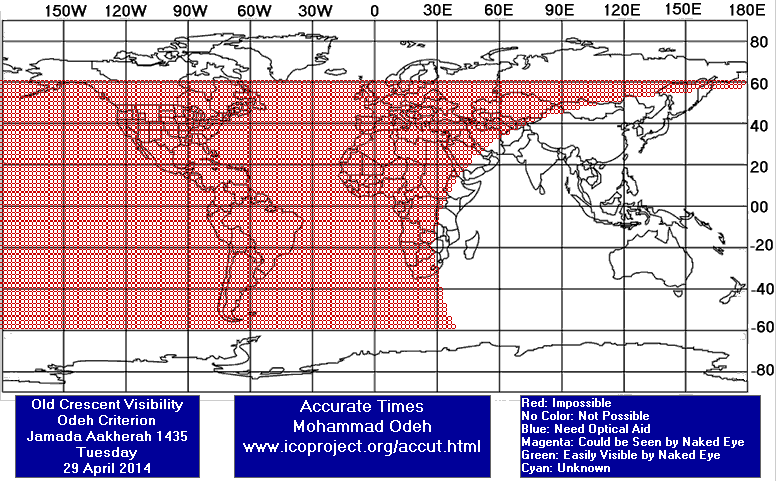
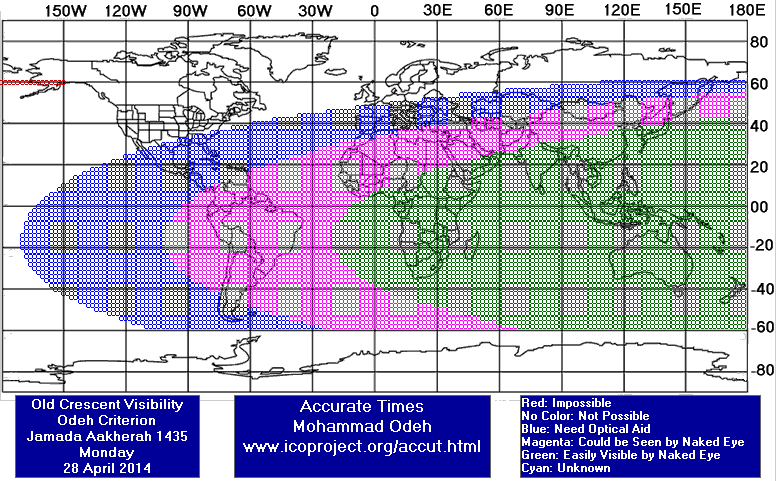
Jumadal Al-Aakherah Waning (OLD) Crescent Observation Results
Mon 28 April 2014
Indonesia
Mr. AR Sugeng Riyadi said: "On Monday, 28 April 2014 I was on Astrophotograph Workshop with Mr. Thierry Legault at Alana Hotel Surabaya East Java Indonesia. We tried to align the telescop at night, but the sky was partly cloudy. The old crescent of Jumadal Tsaniyah 1435 AH was NOT SIGHTED until sunrise. On event with Mr. Thierry Legault we tried to observe the crescent by ccd. And we got the picture after processing. This crescent was seen at daytime and only for astrophotograh education. "
Iran
Tue 29 April 2014
Indonesia
Mr. AR Sugeng Riyadi said: "The crescent was NOT SEEN on Tuesday, 29 April 2014 because it will be a Solar Eclipse across south area of Indonesia. We are from CASA|Club Astronomi Santri Assalaam, tried to observe the Solar Eclipse on Teleng Ria Beach of Pacitan East Java. We got the nice picture of the Partial Solar Eclipse."
